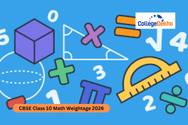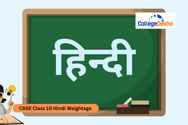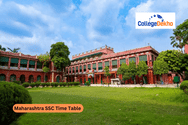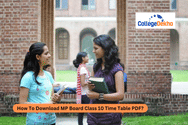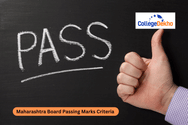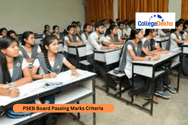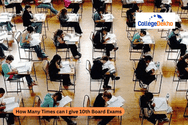

Never Miss an Exam Update
About Karnataka SSLC Science Syllabus 2026
Karnataka SSLC Science theory paper will be conducted for 80 marks. Science is one of the core subjects in the Karnataka SSLC Exam 2025. The Science syllabus comprises three sub-subjects, namely, Physics, Chemistry, and Biology. A total of 16 chapters are in the syllabus. The highest weightage carrying chapters are Chapters 1 (Electricity) and 2 (Light Reflection and Refraction). According to the Karnataka SSLC Science Exam Pattern 2026 , the maximum marks allotted for the exam are 100, out of which 80 marks will be evaluated based on the theory paper, and 20 marks for the practical exam.
You are required to get a minimum of 35% out of the total 100 marks (including practical and theory) to pass the exam. The paper will be conducted in the morning shift, i.e., 10:30 AM – 1:45 PM. You can download the Karnataka SSLC Science Model Paper 2026 for revision. Here in this article, we have provided the complete Karnataka SSLC Science Syllabus 2026.
Karnataka SSLC Science Syllabus 2026: Course Structure
You can refer to the detailed information about the course structure as stated by the Karnataka Examination and Assessment Board from the table given below:
Chapter Number | Chapter Name | Periods | Periods | Marks |
|---|---|---|---|---|
- | - | Teaching | Activity | - |
1 | Chemical Reaction and Equations | 7 | 2 | 4 |
2 | Acids, Bases and Salts | 10 | 4 | 6 |
3 | Metals and Non-metals | 10 | 3 | 6 |
6 | Life Processes | 10 | 4 | 6 |
7 | Control and Coordination | 9 | 2 | 5 |
12 | Electricity | 12 | 4 | 7 |
13 | Magnetic Effects of Electric Current | 11 | 3 | 6 |
15 | Our Environment | 3 | 1 | 2 |
4 | Carbon and its Compounds | 11 | 3 | 6 |
5 | Periodic Classification of Elements | 6 | 1 | 3 |
8 | How do Organisms Reproduce | 8 | 3 | 5 |
9 | Heredity and Evolution | 11 | 2 | 6 |
10 | Light Reflection and Refraction | 12 | 4 | 7 |
11 | The Human Eye and the Colourful World | 9 | 1 | 5 |
14 | Sources of Energy | 6 | 1 | 3 |
16 | Sustainable Management of Natural Resources | 5 | 2 | 3 |
Total | - | 140 | 40 | 80 |
Also Read - Karnataka SSLC Science Previous Year Question Paper
Karnataka SSLC Science Syllabus 2026
The following chapters and units are included in the Karnataka SSLC Science Syllabus 2026 according to the latest curriculum PDF available online:
Chapter Name | Topics |
|---|---|
Chemical Reaction and Equations | Chemical equation, Balanced chemical equation, Implication of a balanced chemical equation, types of chemical reactions: combination, decomposition, displacement, double displacement, precipitation, neutralization, oxidation, and reduction. |
Acids, Bases and Salts | Their definitions in terms of furnishing of H+ AND OH- ions, General properties, examples, and uses, the concept of pH scale (Definition relating to logarithm not required), the importance of pH in everyday life; preparation and uses of Sodium Hydroxide, Bleaching powder, Baking soda, washing soda and Plaster of Paris. |
Metals and Non-metals | Properties of metals and non-metals; Reactivity series; Formation and properties of ionic compounds; Basic metallurgical processes; Corrosion and its prevention. |
Life Processes | ‘Living Being’. Basic concept of nutrition, respiration, transport, and excretion in plants and animals. |
Control and Coordination | Tropic movements in plants; Introduction of plant hormones; Control and coordination in animals; Nervous system; Voluntary, involuntary and reflex action; Chemical coordination; animal hormones. |
Electricity | Effects of Current Electric current, potential difference, and electric current. Ohm’s law; resistance, resistivity, factors on which the resistance of a conductor depends. Series combination of resistors, parallel combination of resistors, and its applications in daily life. Heating effect of electric current and its applications in daily life. Electric power, Interrelation between P, V, I, and R. |
Magnetic Effects of Electric Current | Magnetic field, field lines, field due to a current carrying conductor, field due to current carrying coil or solenoid; Force on a current carrying conductor, Fleming’s Left-hand rule, Electric motor, Electromagnetic induction. Induced potential difference, Induced current. Fleming’s right-hand rule, electric generator, direct current. Alternating current: frequency of AC. Advantage of AC over DC. Domestic electric current. |
Our Environment | Eco-system, environmental problems, ozone depletion, waste production, and their solutions. Biodegradable and non – biodegradable substances. |
Carbon and its Compounds | Tropic movements in plants; Introduction of plant hormones; Control and coordination in animals; Nervous system; Voluntary, involuntary, and reflex action; Chemical coordination; animal hormones. |
Periodic Classification of Elements | Need for classification, early attempts at classification of elements (Dobereiner’s Triads, Newland’s Law of Octaves, Mendeleev’s periodic table), Modern periodic table, gradation in properties, valency, atomic number, metallic and non-metallic properties. |
How do Organisms Reproduce | Reproduction in animals and plants (asexual and sexual) reproductive health needs and methods of family planning. Safe sex vs HIV/AIDS. Childbearing and women’s health. |
Heredity and Evolution | Heredity; Mendel’s contribution – Laws for inheritance of traits: Sex determination: brief introduction; Basic concepts of evolution. |
Light Reflection and Refraction | Natural phenomena Reflection of light by curves surfaces; Images formed by spherical mirrors, center of curvature, principal axis, principal focus, focal length, mirror formula (Derivation not required), magnification. Refraction; Laws of refraction, refractive index. Refraction of light by spherical lens; Image formed by spherical lenses; Lens formula (Derivation not required); Magnification. Power of a lens. |
The Human Eye and the Colourful World | Functioning of a lens in the human eye, defects of vision and their corrections, and applications of spherical mirrors and lenses. Refraction of light through a prism, dispersion of light, scattering of light, applications in daily life. |
Sources of Energy | Different forms of energy, conventional and non-conventional sources of energy: Fossil fuels, solar energy; biogas; wind, water, and tidal energy; Nuclear energy: Renewable versus non-renewable sources of energy. |
Sustainable Management of Natural Resources | Conservation and judicious use of natural resources. Forest and wildlife; Coal and Petroleum conservation. Examples of people’s participation in the conservation of natural resources. Big dams: advantages and limitations; alternatives, if any. Water harvesting. Sustainability of natural resources. |
You must have detailed information about the Karnataka SSLC Science Syllabus 2026 when getting ready to appear for the exam. Make sure to construct a study plan based on the latest curriculum, and you can also revise using model test papers.
Are you feeling lost and unsure about what career path to take after completing 12th standard?
Say goodbye to confusion and hello to a bright future!

FAQs
The students can quickly revise the Karnataka SSLC Science Syllabus 2026 by solving the questions. They can download the model papers and check their preparation level. For quick revision, students can also use the notes made by them during preparation.
Students will need at least 5 to 6 months to cover the entire Karnataka SSLC Science Syllabus 2026 since it can be very extensive and hard to understand if you are starting from scratch.
Students can buy the latest NCERT book to get information about the Karnataka SSLC Science Syllabus 2026 or they can also visit the official website of KSEAB.
No major changes have been recorded in the Karnataka SSLC Science Syllabus 2026 however students need to check the latest curriculum to start getting ready for the exam since there can be some minor changes in the chapters of the topics included in the syllabus.
According to the Karnataka SSLC Science Syllabus 2026, the following topics are included in the curriculum: Chemical Reactions and Equations, Acids, Bases and Salts, Metals and Non-metals, Life Processes, Control and Coordination, Electricity, Magnetic Effects of Electric Current, Our Environment, Carbon and its Compounds, Periodic Classification of Elements, How do Organisms Reproduce, Heredity and Evolution, Light Reflection and Refraction, The Human Eye and the Colourful World, Sources of Energy, and Sustainable Management of Natural Resources.
To get the Karnataka SSLC Science Syllabus 2026 offline, students can directly buy the latest NCERT books or contact their teachers to get a hard copy of the curriculum PDF if they are not able to access the internet.
Was this article helpful?








